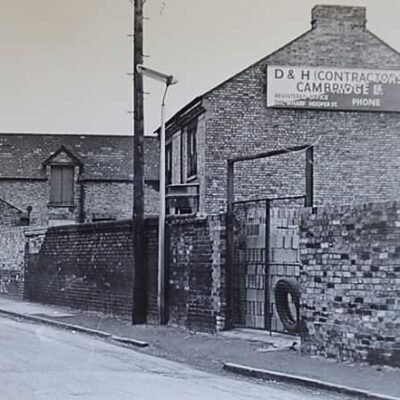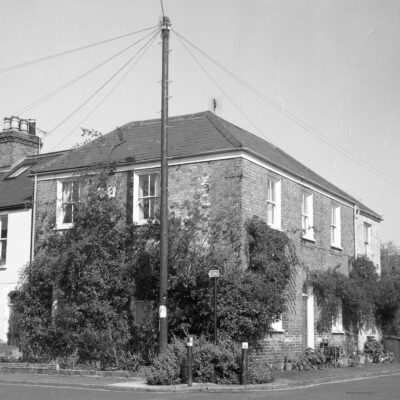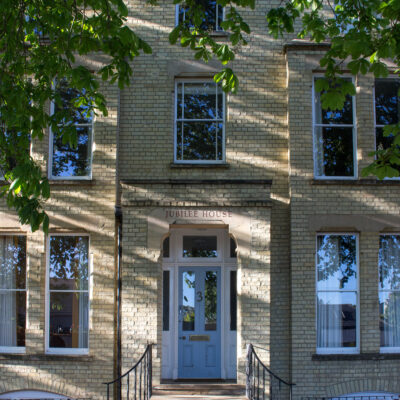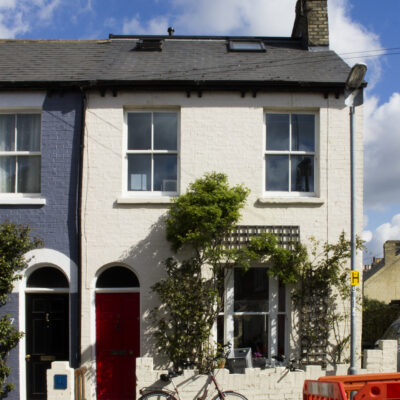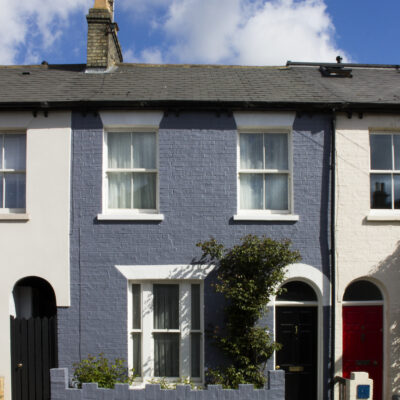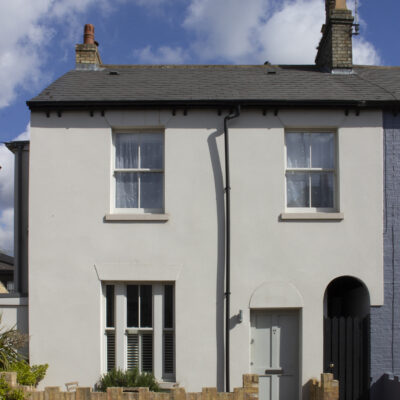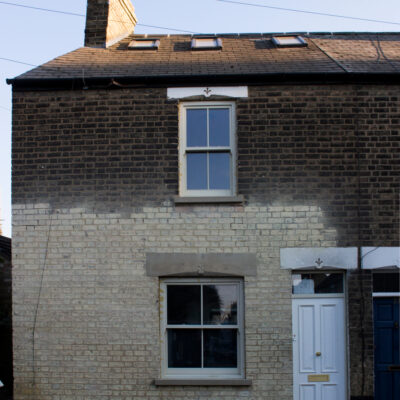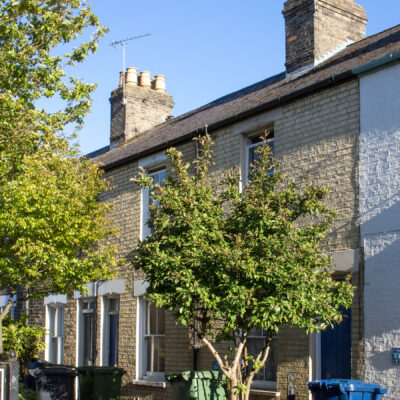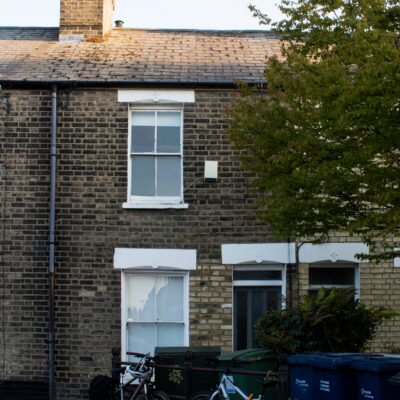Search by topic
- archaeology
- Building of Local Interest
- charity
- church
- crime
- dressmaker
- fire
- Great Eastern Railway
- Listed building
- Mapping Relief
- medieval
- oral history
- poverty
- Public House
- Rattee & Kett
- Religious House
- Roman
- scholar
- school
- Then and Now
- tudor
- women
- work
- world war one
- world war two
Search by text
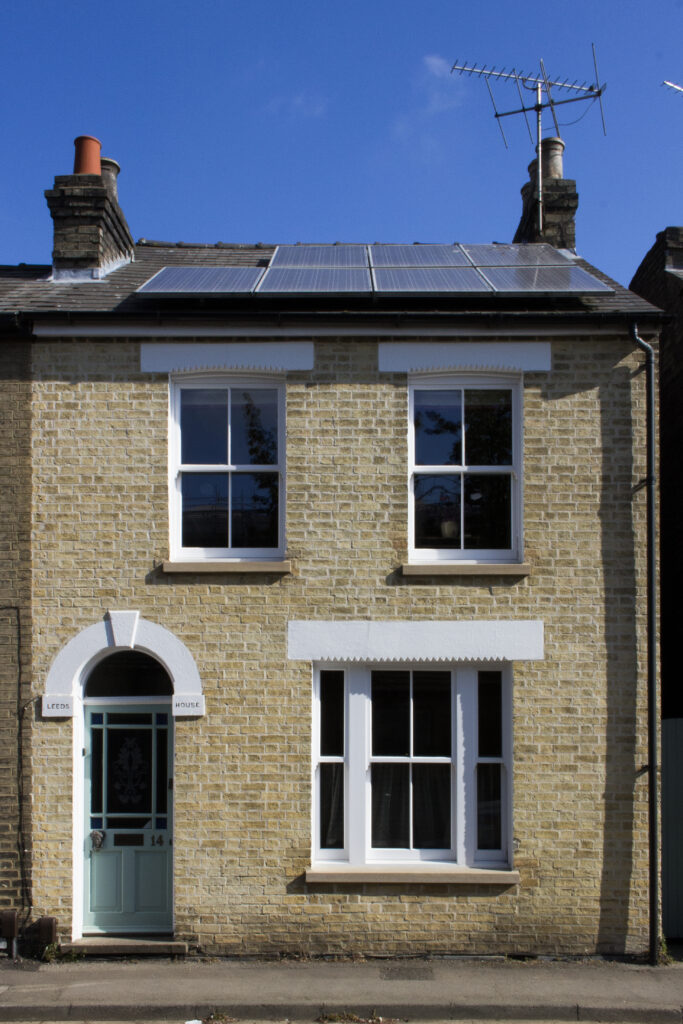
14 Hooper Street
A shoemaker from Leeds, and a tailor's workshop
14 Hooper Street, also called Leeds House, is on the north side of Hooper Street. It is joined on one side to no. 13, Leeds Cottage.
1881 census
Thomas Holder, 51, cordwainer, b. Leeds, Yorkshire
Mary A. Holder, 47, b. Cambridgeshire
Edwin Greenwood, lodger, 28, carpenter, b. Thaxted, Essex
1891 census
Thomas Holder, 61, retired shoe maker, b. Leeds, Yorkshire
Mary A Holder, 56, b. Cambridge
Edward Greenwood, lodger, 35, carpenter, b. Thaxted, Essex
Thomas Holder, first resident of Leeds House, was in fact from Leeds. He had moved to Cambridge by 1859, when he married Mary Ann Lawrence. In the 1870s he bought almost the entire strip of land on one side of Hooper Street, from Sturton Street to Ainsworth Street. He had Leeds House built for himself and Mary Ann, along with 11 cottages (11-13 and 15-22 Hooper Street) to rent out.
Thomas Holder died in 1892 and Mary Ann in 1900. The Cambridge Chronicle of 26 January 1900 advertised the auction of the house contents: ‘All the valuable household furniture, comprising contents of dining and drawing rooms, the bedroom appointments, kitchen requisites, the linen, silver and plated goods and jewellery.’ The following month (Cambridge Daily News, 23 February 1900), the entire property portfolio was auctioned, including the 11 adjoining tenanted cottages, two cottages in Norfolk Street, and a plot of land in Priory Road. Leeds House was bought for £260 (Cambridge Chronicle, 2 March 1900) by Thomas Hinson, a tailor.
1901 census
Thomas Hinson, 50, tailor, b. Cambridge
Alice Hinson, 38, b. Cambridge
Sissy Hinson, 14, b. Cambridge
May Hinson, 11, b. Cambridge
Alfred Hinson, 10, b. Cambridge
Hinson, 4 days, b. Cambridge
Edward Greenwood, boarder, 48, carpenter, b. Thaxted, Essex
Apparently the lodger Edward Greenwood had been transferred to the new owners as a fixture of the house, but the arrangement may not have been a happy one. The Cambridge Daily News of 24 June 1902 reports that Thomas Hinson allegedly assaulted Edward Greenwood: ‘At supper time on the day in question he was sitting on a chair, when Hinson threw a loaf at his wife. It went through the window. Defendant then struck him two deliberate blows in the left eye with his fist, or something hard in his hand. Witness found the front door, and went out. He was dazed and could not say whether the defendant hit him out of the house.’ Neighbour William Ludman of no. 20 testified that he had seen Hinson kicking and hitting Greenwood in the street. Thomas Hinson was fined £1 plus costs.
1911 census
Thomas Hinson, 62, tailor, b. Cambridge
Alice Hinson, 43, b. Cambridge
Cissy Hinson, 23, b. Cambridge
Alfred Hinson, 20, tailor apprentice, worker, at home, b. Cambridge
Beatrice Hinson, 10, b. Cambridge
25 years married, 9 children, 5 died
The Hinson family had been touched by tragedy. In the 1890s five of their children – including a twin – had died very young, some within a few weeks of birth. At the time of the 1901 census they had three surviving children over the age of 10 – Sissy, May and Alfred – and a 4 day-old baby girl, as yet unnamed. That tiny baby, christened Maud Beatrice, was to live to the age of 87.
In 1911 three of the children were still living at home, but the eldest, Sissy, was now blind. Her brother Alfred helped Thomas with his tailoring business at home, but he also worked as a printer.
1921 census
Alice Hinson, mother, widow, 55, home duties, b. Cambridge
Alice S Hinson, daughter, 33, b. Cambridge
Latham Lander, boarder, 61, coal carter, Coote & Warren, Hooper St, b. Grantchester
Thomas died in 1918. In 1939 Alice, Sissy and Maud were still living at 14 Hooper Street. Sissy was now diabetic as well as blind. She died in 1941.
In 1939 Maud was working as a college bedmaker. In 1922 she had married LNER engine driver Lawrence Bishop, and as late as 1930 he is listed in the electoral register for 14 Hooper Street. In that same year, however, he is also listed in the electoral register for Papworth Hall, which was then an experimental colony for the treatment of tuberculosis, founded in 1916. Many of the earliest patients were World War I soldiers who had contracted tuberculosis in the trenches. At that time, before antibiotics were available, treatment of tuberculosis relied on exposure to fresh air, and patients often slept on open balconies. Sadly, Lawrence Bishop never returned home permanently, and he died in Papworth in 1944.
After Alice died in 1946, her grandson Alfred Stanley Hinson lived in the house with his family. The Hinson family sold the house to the present owners in 1982.
Sources
UK census records (1841 to 1921), General Register Office birth, marriage and death indexes (1837 onwards), the 1939 England and Wales Register, electoral registers, and local newspapers available via www.britishnewspaperarchive.co.uk.
For the origins of Royal Papworth Hospital, see https://royalpapworth.nhs.uk/our-hospital/our-history.
Contribute
Do you have any information about the people or places in this article? If so, then please let us know using the Contact page or by emailing capturingcambridge@
License
This work is licensed under CC BY-NC-SA 4.0





